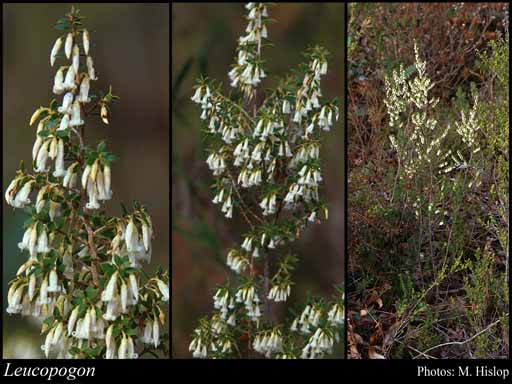- Reference
- Prodr. 541 (1810)
- Name Status
- Current







Scientific Description
Family Epacridaceae.
Habit and leaf form. Small trees, or shrubs; evergreen; leptocaul, or pachycaul. Helophytic to xerophytic. Leaves minute to medium-sized; alternate, or whorled; spiral, or four-ranked; ‘herbaceous’, or leathery; imbricate, or not imbricate; usually sessile, or petiolate; non-sheathing; simple. Leaf blades entire; flat, or rolled; palmately veined, or parallel-veined (in L. sect. Heteranthus); cross-venulate, or without cross-venules. Leaves without stipules. Leaf blade margins flat, or revolute. Stem anatomy. Nodes unilacunar. Secondary thickening developing from a conventional cambial ring.
Reproductive type, pollination. Fertile flowers hermaphrodite. Unisexual flowers absent. Plants hermaphrodite. Entomophilous, or ornithophilous. Pollination mechanism unspecialized.
Inflorescence and flower features. Flowers solitary, or aggregated in ‘inflorescences’; in spikes, or in racemes. Inflorescences terminal, or axillary. Flowers bracteate; bi- bracteolate; small; fragrant, or odourless; regular; 5 merous; cyclic; tetracyclic. Free hypanthium absent. Hypogynous disk present; intrastaminal; annular, or of separate members (5 scales). Perianth with distinct calyx and corolla; 10; 2 -whorled; isomerous. Calyx 5; 1 -whorled; polysepalous; imbricate; regular; persistent. Corolla 5; 1 -whorled; gamopetalous; lobed (lobes spreading or reflexed); valvate; regular; glabrous abaxially; hairy adaxially (lobes bearded inside with white woolly hairs); white, or pink; persistent, or deciduous. Androecium 5. Androecial members adnate (to the corolla); all equal; free of one another; 1 -whorled. Androecium exclusively of fertile stamens. Stamens 5. Staminal insertion in the throat of the corolla tube. Stamens remaining included, or becoming exserted (partially); isomerous with the perianth; oppositisepalous; all alternating with the corolla members. Filaments glabrous; short, slender, terete. Anthers basifixed, or adnate; becoming inverted during development, their morphological bases ostensibly apical in the mature stamens; non-versatile; dehiscing via longitudinal slits (by a single median slit); finally introrse (inverting during development); unilocular, or bilocular; bisporangiate; unappendaged (but their apices in L. ‘A’ sterile-tipped, generally paler and often recurved). Pollen shed in aggregates, or shed as single grains; without viscin strands; in tetrads. Gynoecium 2–5 carpelled. The pistil 2–5 celled. Gynoecium syncarpous; eu-syncarpous; superior. Ovary plurilocular; 5 locular, or 2–5 locular (or more in L. sect. Heteranthus). Gynoecium stylate. Styles 1; either very short or long and slender; attenuate from the ovary; apical; becoming exserted, or not becoming exserted. Stigmas 1; lobed; truncate, or clavate, or capitate. Placentation apical. Ovules 1 per locule; pendulous; non-arillate; anatropous.
Fruit and seed features. Fruit fleshy, or non-fleshy; indehiscent; a drupe. The drupes with one stone. Seeds endospermic. Endosperm oily. Seeds wingless. Embryo well differentiated. Cotyledons 2. Embryo straight. Seedling. Germination phanerocotylar.
Physiology, biochemistry. Aluminium accumulation not found. Photosynthetic pathway: C3.
Geography, cytology, number of species. Native of Australia. Not endemic to Australia. Australian states and territories: Western Australia, South Australia, Queensland, New South Wales, Victoria, and Tasmania. South-West Botanical Province.
Additional characters Prophylls few.
Taxonomic Literature
- Hislop, Michael 2012. Leucopogon navicularis (Ericaceae: Styphelioideae: Styphelieae), another local endemic from the midwest region of Western Australia.
- Hislop, Michael 2011. A reinstatement and a new combination in Leucopogon (Ericaceae: Styphelioideae: Styphelieae).
- Hislop, Michael 2011. New, locally endemic taxa in Leucopogon (Ericaceae: Styphelioideae: Styphelieae) from the Perth and midwest regions of Western Australia.
- Hislop, Michael 2008. Three new species of Leucopogon (Ericaceae: Styphelioideae: Styphelieae) from the far south-west of Western Australia.
- Hislop, M.; Chapman, Alex R. 2007. Three new and geographically restricted species of Leucopogon (Ericaceae: Styphelioideae: Styphelieae) from south-west Western Australia.
- Wheeler, Judy; Marchant, Neville; Lewington, Margaret; Graham, Lorraine 2002. Flora of the south west, Bunbury, Augusta, Denmark. Volume 2, dicotyledons. Australian Biological Resources Study.. Canberra..
- Marchant, N. G.; Wheeler, J. R.; Rye, B. L.; Bennett, E. M.; Lander, N. S.; Macfarlane, T. D.; Western Australian Herbarium 1987. Flora of the Perth region. Part one. Western Australian Herbarium.. [Perth]..
- Strid, Arne 1986. New species of Leucopogon and Conostephium (Epacridaceae) from SW Australia.
- Blackall, William E.; Grieve, Brian J. 1981. How to know Western Australian wildflowers : a key to the flora of the extratropical regions of Western Australia. Part IIIB, (Epacridaceae-Lamiaceae). University of W.A. Press.. [Perth]..